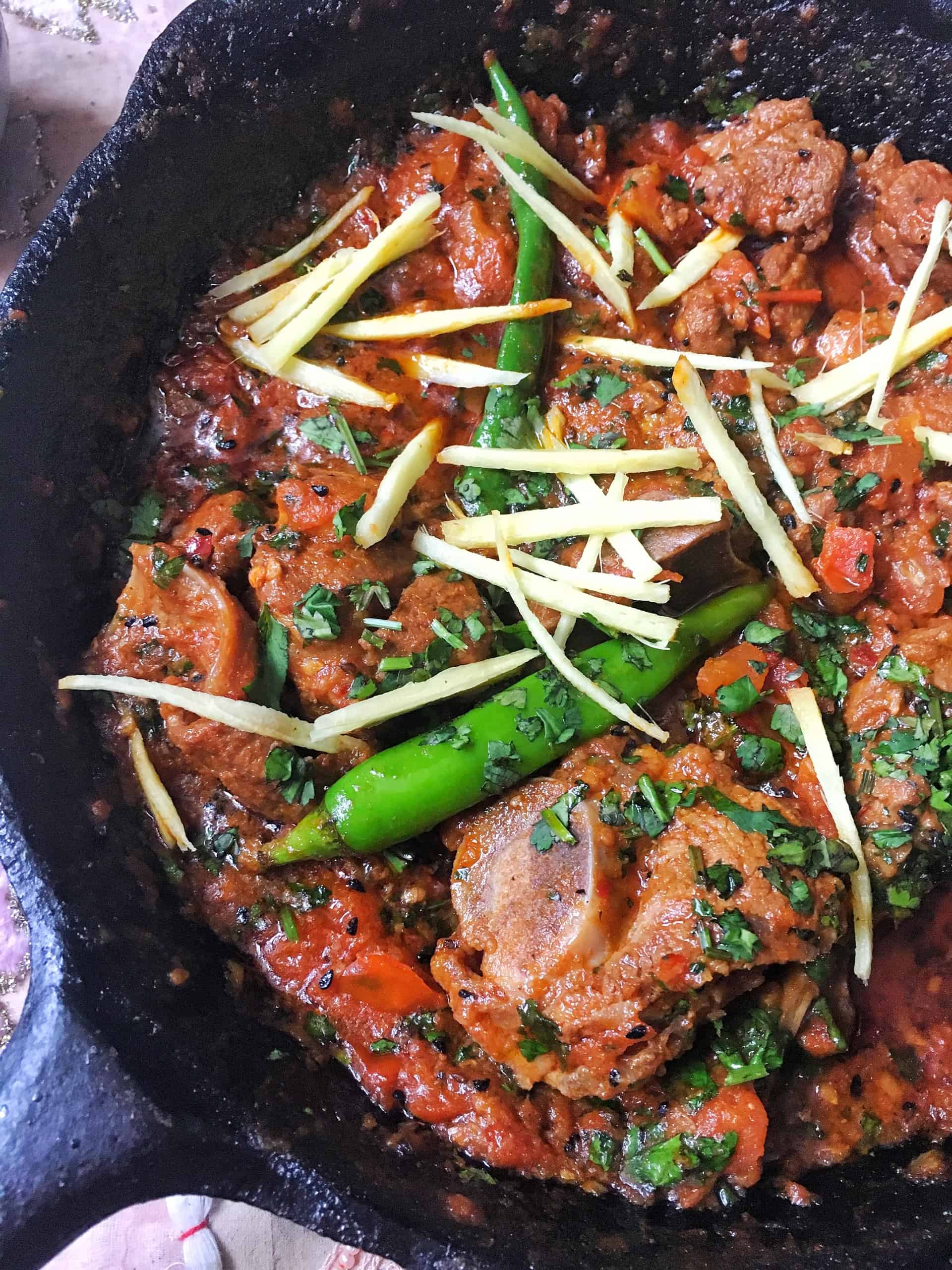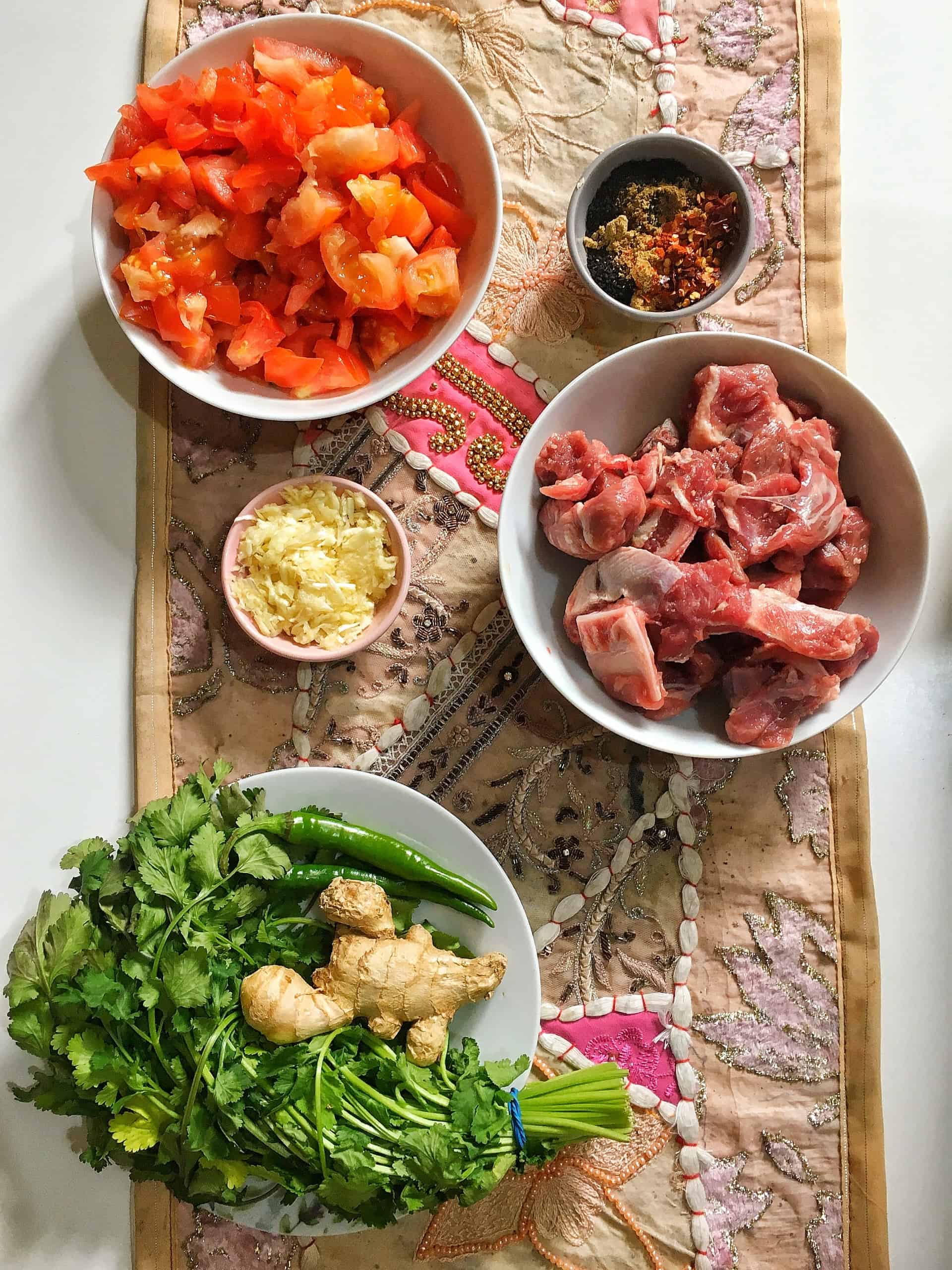Often found on the menus of dhabbas and restaurants all around Pakistan, served on special occasions and get-togethers, Karahi is just the epitome of good Pakistani food. I’ve spoken about how dear Karahis are to me and my memories of family dinners growing up here in my Chicken Karahi recipe. In essence, a Karahi for me was the Desi equivalent of Sunday roast. This recipe is a follow-on of that Chicken Karahi recipe - the red meat equivalent which is equally as loved (and perhaps even preferred) by many. The recipe I’m sharing today is for both a lamb and mutton Karahi. I’ve grouped both together because they are very similar meats, the only difference being their cook time. Lamb I find is cooked more frequently here in the UK than mutton and mutton is the red meat of choice in Pakistan and many other countries. Safe to address both in one recipe, I say!
🍅 What is a Karahi?
I’ve addressed this at more length in my Chicken Karahi recipe, but will give a quick sum up here. The famous Karahi curry has taken its name after the name of the wok-like pan it’s traditionally cooked in. However, the pan isn’t its most defining feature. A Karahi is a tomato, ginger and garlic-heavy curry which traditionally is not cooked with onions or yogurt, unlike most other Pakistani curries. This is what separates it from curries like a Lamb Bhuna, Korma or a Dopiaza - the lack of onions and yogurt. Over the years, the traditional Karahi has been altered to suit the many different dhabas and restaurants it’s served at by bulking up the masala with onions and/or yogurt, which are a lot cheaper than tomatoes. Some even contain capsicum, like a Jalfrezi! Because to this, a lot of people don’t really know what a real Karahi actually is, and generally think it’s synonymous with a thick, red curry. Of course, adding onions into the masala alters the taste and texture. When you make the masala as it is traditionally made, with a heavy hand on the ginger and garlic and plenty of tomatoes, you’ll get the real deal, authentic flavour and mark my words, you will be blown away! For those who may be skeptical of whether a curry without onions would be enough or even work, I am here to assure you… This masala is plentiful and finger-licking delicious, as long as you follow my instructions and tips! We don’t gatekeep here 😉
📌 Karahi Cooking Ground Rules
I just want to lay down some rules when it comes to cooking any Karahi recipe, just so you can really get a feel of how Karahis are an inherently different to other curries.
Fresh ginger, garlic and tomatoes only - no tinned or jarred ingredients, please. Mince the ginger and garlic fresh, chop the fresh tomatoes and ensure your coriander and green chilli is fresh too! Trust me, it makes all the difference here. There’s a HUGE emphasis on fresh and crisp flavours in a Karahi, and you just can’t replicate that with tinned or frozen ingredients. We gotta use a LOT of ginger and garlic - it delivers the most amazing flavour AND also helps bulk up the masala! I use one entire bulb of garlic for this recipe, but you can easily use two if you want a pronounced garlicky flavour. Same goes for the ginger too, easily double-able! You need to use your own initiative a bit with cook times - I talk about this in the Method section below. Essentially, don’t follow my timings blindly because there is a HUGE amount of variation between the type, cut and country of origin of your meat, and how it impacts the cook time and moisture content. My timings worked for me, living in the UK - they may not work for you because red meat can be a bit fickle with timings!
🥣Method
See below for the pictorial instructions. As always, full ingredients and instructions are at the bottom of the post. We’ll start by heating up a pan, wok or karahi over a high heat and adding our meat. Once the meat has changed colour and no longer remains pink, add in some fresh minced ginger and garlic. Once the garlic and ginger has had 1-2 minutes of fry-time, we’ll add our spices including the salt and some water, cover and cook over a low heat until the meat is almost done. By this stage, you should have very little water left in the pan. However, if you do, please turn the heat to high and cook it off till there’s very little left. Once the cook time is up, in go our chopped tomatoes. Turn the heat to high, and cook over a high heat without the lid, stirring very often. Agitating the tomatoes will help them break down quicker.
If your meat is still tough after the cook time stated, cook it for a bit longer with the lid on till it’s tender If you need to add more water, add more water If you have a ton of water left in the pan after the cook time is up, dry the water out before adding the tomatoes. Do not proceed before drying the water out!
The tomatoes will begin to release A LOT of juice. Like, A LOT. Do NOT panic if the pan looks like it’s overflowing with tomato juice. I have this panic every single time I cook a Karahi. I think ‘How will all this water EVER dry out?!’. But trust the process. I always say if you’re not worried when you look at the pan at this stage, you’re doing it wrong 😉 Continue to dry out everything over a high heat, stirring very often, and eventually you will be rewarded with a thick, jammy, glossy masala. Once the masala is thick, glossy, clinging onto the meat and the oil has risen to the top/separating at the edges, add some chopped coriander and green chillies. Turn the heat to low and simmer this without the lid for 5 minutes. Garnish with some more fresh coriander and ginger. Serve hot with naan, fizzy drinks and salad!
⏱️Instant Pot instructions
To cook this recipe in an Instant Pot:
Follow Step 1 and 2 using the Sauté mode. Add the spices and the lower suggested quantities of water as per Step 3, then switch to Pressure Cook mode. For lamb, input 10 minutes, and for mutton, input 20 minutes. Select the Automatic/Quick Steam Release option to prevent overcooking. If there’s moisture in the pot, do not proceed before drying it off completely using Sauté mode. Proceed with the rest of the recipe using Sauté Mode
Many Instant Pot models aren’t so great at getting a close, high-heat sauté that’s required for this recipe. The model I have, the Instant Pot Duo Crisp with Ultimate Lid, is fantastic at this very crucial step in Pakistani cooking. I talk about it more here in this post, check it out!
🍽️Serving Suggestions
A Karahi is best served with some hot naan (try my homemade Roghi Naan recipe!) and a cooling finely chopped salad on the side. If you’d like to serve it alongside other food, it would pair well with something soupy, like Tadka Dal, to balance out the dry sauce. Alternatively, a good raita can balance out the dry sauce too! For a more KPK/Afghanistani spread, you can serve this alongside Kabuli Pulao and a yogurt-based side like Borani or Mast o Khiar.
If you make this dish, I’d love to see it! You can show me on Instagram - I’m @fatima.cooks 🙂
📋 Recipe
Enter your email & I’ll send it right over. Plus, you’ll get bonus Pakistani food-goodness from Fatima Cooks, like new recipe alerts, exclusive email-only recipes + more! By submitting this form, you consent to receive emails from me. Your details are secure. Opt-out any time.










